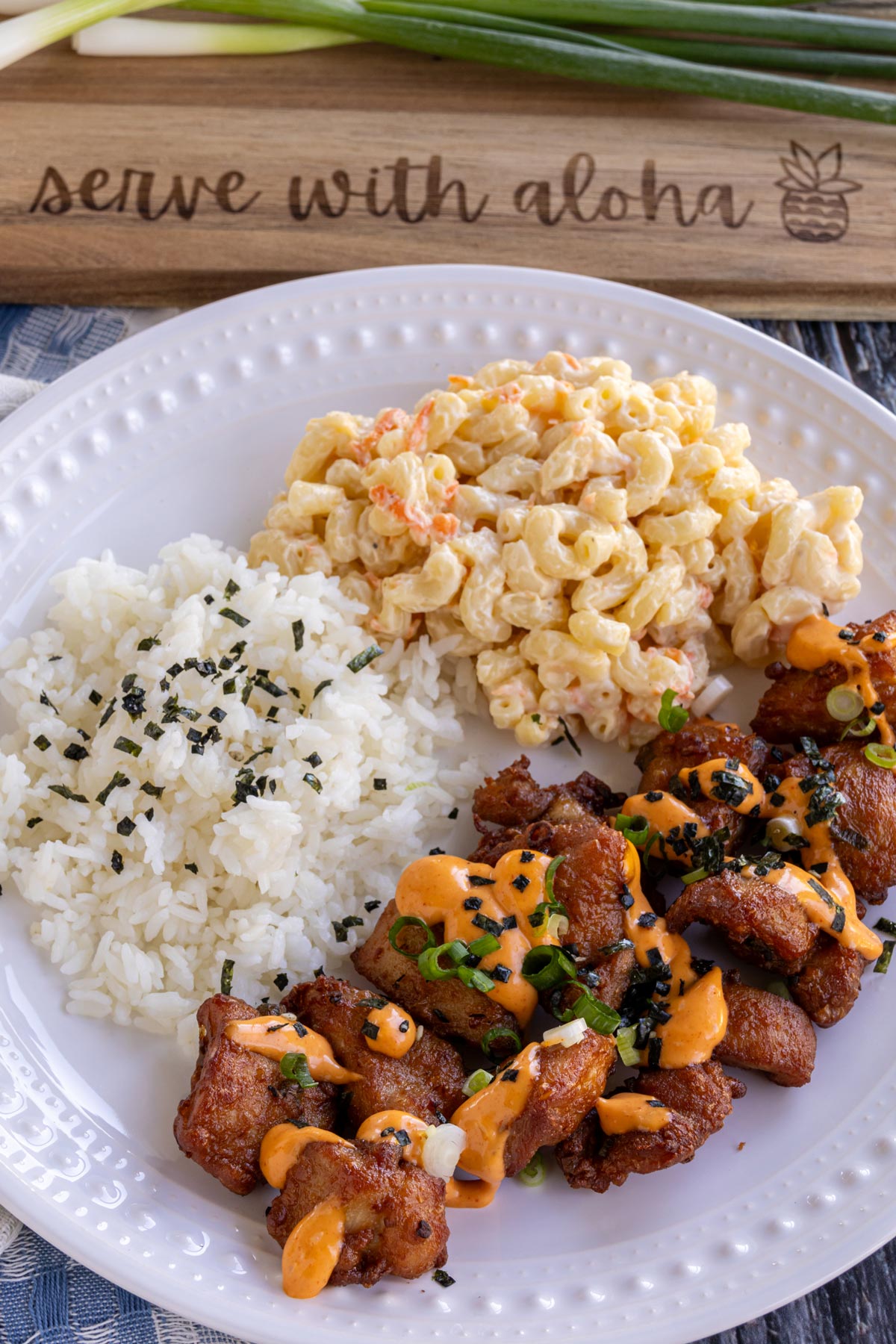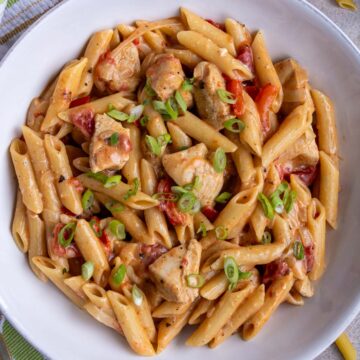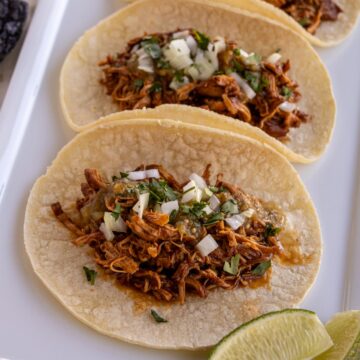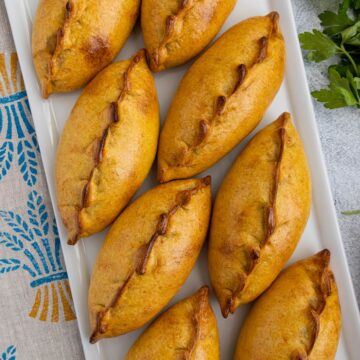Mochiko Chicken is a popular Hawaiian fried chicken dish made with bite-size pieces of marinated and deep-fried chicken thighs. They’re crispy and flavorful, perfect served just as they are with mac salad and rice, or elevated with a drizzle of gochujang aioli and furikake.

Mochiko chicken is a Hawaiian style of fried chicken bites. This beloved dish is a result of Japanese influence on the food culture in Hawaii. It’s somewhat similar to Japanese chicken karaage, which uses cornstarch or potato starch instead of the mochiko flour (sweet rice flour) found in mochiko chicken.
The addition of mochiko flour results in a crispy yet uniquely chewy coating. At Tin Roof Maui, Chef Sheldon Simeon (one of my favorite Top Chef contestants) takes his mochiko chicken to another level. He makes an extra-crunchy version by not only marinating but breading whole chicken thighs before frying. The result is a super crispy flavor bomb, finished with a duo of sauces and mochi crunch.
I’ve kept my recipe closer to the classic, skipping the additional breading, but I include a fantastically flavorful gochujang aioli as an optional topping along with a shower of furikake. In my Expert Tips section below, I include some notes on adjusting this recipe to make more of a Tin Roof-style mochiko chicken, if that’s what you’d like to try.
Ingredient notes

- Chicken: Mochiko chicken is typically made with chicken thighs. They are often cut into chunks, marinated and then fried. In this recipe, I use boneless skinless chicken thighs. Occasionally, like they do at Tin Roof Maui, whole boneless skin-on chicken thighs are used, and then are sliced into strips after frying. If you want to follow their lead, I provide alternative instructions below on making more of a Tin Roof-style mochiko chicken (which is also breaded after marinating).
- Mochiko Flour: You certainly can’t make mochiko chicken without the mochiko flour! Mochiko flour is a type of sweet rice flour or glutinous rice flour (it's called that even though it's gluten-free). It’s also used to make Japanese mochi and Hawaiian butter mochi. I use Koda Farms brand, which comes in 1 pound boxes. There is no good substitute for mochiko flour, so make sure to use it for this recipe.
- Cornstarch: Cornstarch helps balance out the mochiko flour in the marinade to provide a crisp and light finish. People use slightly different ratios of mochiko flour to cornstarch but 1:1 is a pretty standard ratio and works well.
- Soy Sauce: Use shoyu (Japanese style soy sauce) in the marinade, as it’s ubiquitous throughout Hawaii and definitely the soy sauce of choice. I prefer using the low-sodium variety. I feel this provides plenty of salt (and flavor), especially with the longer marinade time. The full-sodium varieties are always way too salty for me. If you’d like to make this dish gluten-free, use tamari.
- Egg: Eggs help bind the batter to the chicken and provide an even coating.
- Oil: For deep-frying, use a neutral, high-smoke point oil such as canola or vegetable oil.

How to make it
To make the marinade, whisk together mochiko flour, cornstarch, sugar, soy sauce, scallions, eggs, garlic, ginger, and salt.


Add chicken and stir to coat.


Cover the bowl tightly (or transfer mixture to a sturdy zip-top bag freezer bag) and refrigerate to marinate for at least 4 hours or preferably overnight (I did 8 hours for these photos and it was absolutely delicious!).
If desired, make gochujang aioli for dipping or drizzling over your chicken. In a small bowl, whisk together mayonnaise, gochujang, water, sugar, garlic and salt. Cover and refrigerate until ready to serve.


Line a baking sheet with aluminum foil (for easy cleanup) and place a wire rack on top. Alternatively you could line a sheet pan with paper towels and skip the rack but I find the rack does a better job of keeping fried items crispy rather than just soaking up excess oil.
Fill a Dutch oven or pot with high sides (or a deep fryer) with oil reaching a depth of at least 1-inch. Heat the oil to 350°F (175°C).
Stir the chicken in the marinade as the cornstarch will have settled to the bottom over time.
Without crowding the pot, add as many chicken pieces as you can to the oil and fry for about 4 to 5 minutes. Periodically use a spider skimmer or fork to occasionally agitate the chicken so they don’t stick to each other or the bottom of the pot.


Remove cooked chicken and place on the wire rack to drain. Repeat with remaining chicken.

Garnish the mochiko chicken with a drizzle of gochujang aioli, if desired, and top with scallions and furikake, if desired. Enjoy with rice and/or add a scoop of Hawaiian mac salad to create your own homemade plate lunch.
Please scroll to the bottom of the post for the full recipe (in a printable recipe card) including ingredient amounts and detailed instructions.

Expert tips
Mochiko chicken is best served hot and crispy, right out of the fryer. If you have leftovers, either reheat them in the oven at 425°F for about 4 minutes per side or in the air fryer (preferred method) at 375°F for about 2 to 3 minutes per side.
Whenever possible, I like to use my deep fryer (the one pictured below is a relic but it still works great!) and do my deep-frying on my covered back deck (I have an electrical outlet there to plug in). It keeps the kitchen from smelling like deep-fried food and is easier for me to clean up.
Regardless of where you do your frying, you can set up your space similar to mine, with the rack set right beside your frying vessel and a kitchen tool (like a fork or spider skimmer) at the ready to help jostle the chicken so it doesn't stick.

Because of the nature of boneless chicken thighs, it can be difficult to portion the pieces evenly. Some parts of the thigh are extremely thin while others are thick. There may also be small pieces that simply break off. Just do your best. It will still taste great even if the pieces aren’t completely uniform in size.
Ideally, serve mochiko chicken as part of a Hawaiian plate lunch. That’s easier than it sounds! Simply pair it with plain white rice (make Calrose rice if you want to be authentically Hawaiian) and mac salad. You could also serve it with garlic noodles like they do at Tin Roof Maui as one of their delicious upgrade options. This is what we did when we dined at Tin Roof!

Alternate Method: Extra Crunchy Tin Roof-Style Mochiko Chicken
Some recipes (like Chef Sheldon’s at Tin Roof Maui) also coat the marinated chicken in a dry mixture before frying. This certainly yields an amazingly crunchy crust, but many mochiko chicken recipes skip this extra step since it’s more of an update rather than part of the traditional method. It also makes it easier to make this recipe gluten-free by skipping the breading which usually contains both cornstarch and all-purpose flour.
If you’d like to adapt these chicken bites into a Tin Roof-style mochiko chicken, here’s how:
Follow the recipe as instructed to marinate the chicken. Note that you could use whole boneless, skin-on chicken thighs instead of smaller pieces if you are sticking closely to the Tin Roof version. Combine equal parts all-purpose flour and cornstarch. Remove the chicken from the marinade, letting any excess batter drip off. Dredge thoroughly in the flour mixture, then shake off excess flour. Proceed with the recipe as directed to fry and serve. If using whole chicken thighs, adjust the cooking time if needed as they will take a bit longer to cook through.

Other recipes you may like
- Authentic Hawaiian Macaroni Salad (Mac Salad)
- Garlic Noodles
- Saimin (Hawaiian Noodle Soup)
- Hawaiian Loco Moco (Hamburger Steak with Gravy)
- Volcano Fries (Garlic Fries with Sriracha Aioli and Furikake)
- Hawaiian Hot Dog (Puka Dog Inspired Recipe)
- Honey Sesame Chicken
- Korean Fried Chicken
Tried this recipe? Please leave a star ⭐️⭐️⭐️⭐️⭐️ rating in the recipe card below and/or a review in the comments section further down the page. You can also follow me on social media on Facebook, Instagram, and Pinterest!

Mochiko Chicken (Hawaiian Fried Chicken)
Ingredients
Mochiko Chicken:
- ¼ cup mochiko flour
- ¼ cup cornstarch
- ¼ cup sugar
- ¼ cup shoyu (light soy sauce) or use tamari to make this dish gluten-free (I prefer and recommend low-sodium soy sauce)
- ¼ cup chopped scallions (about 3 to 4 scallions, white and green parts), plus more for garnish
- 2 large eggs beaten
- 6 cloves garlic minced
- 1 tablespoon minced fresh ginger
- ½ teaspoon kosher salt
- 2 pounds boneless skinless chicken thighs trimmed of excess fat and cut into bite-size pieces (about 1 ½-to-2-inches)
- Vegetable oil (or other neutral flavored oil) for frying
- ¼ cup furikake for garnish (optional)
Gochujang Aioli (Optional):
- ½ cup mayonnaise
- 1 tablespoon gochujang (Korean chili paste)
- 1 tablespoon water
- 1 teaspoon sugar
- 2 cloves garlic grated or crushed
- Pinch kosher salt
Instructions
- In a medium mixing bowl whisk together the mochiko flour, cornstarch, sugar, soy sauce, scallions, eggs, garlic, ginger, and salt. Add the chicken pieces and stir to coat. Cover the bowl tightly (or transfer mixture to a sturdy zip-top bag freezer bag) and refrigerate to marinate for at least 4 hours or preferably overnight.
- If desired, make gochujang aioli for dipping or drizzling over your mochiko chicken. In a small bowl, whisk together the mayonnaise, gochujang, sugar, water, garlic and salt. Cover and refrigerate until ready to serve.
- Line a baking sheet with aluminum foil (for easy cleanup) and place a wire rack on top. Alternatively you could line a sheet pan with paper towels and skip the rack but I find the rack does a better job of keeping fried items crispy rather than just soaking up excess oil.
- Fill a Dutch oven or pot with high sides (or a deep fryer) with oil reaching a depth of at least 1-inch. Heat the oil over medium-high heat until it reaches a temperature of 350°F (175°C).
- Stir the chicken in the marinade as the cornstarch will have settled to the bottom over time. You want to reintegrate it into the batter to provide a very thin coating on the chicken pieces.
- Without crowding the pot, add as many chicken pieces as you can to the oil and fry for about 4 to 5 minutes, using a spider skimmer or fork to occasionally agitate the chicken so they don’t stick to each other or the bottom of the pot. They should be dark golden brown all over, and register an internal temperature of 165°F (74°C) with an instant read thermometer.
- Remove cooked chicken with the spider skimmer (or the fryer basket if using a deep fryer) and place on the wire rack to drain. Repeat with remaining chicken.
- Garnish the mochiko chicken with a drizzle of gochujang aioli, if desired, and top with scallions and furikake, if desired. Enjoy with rice and/or add a scoop of Hawaiian mac salad to create your own homemade plate lunch. You could also serve it with garlic noodles like they do at Tin Roof Maui as one of their delicious upgrade options.
Notes
- Mochiko chicken is best served hot and crispy, right out of the fryer. If you have leftovers, either reheat them in the oven at 425°F for 4 to 5 minutes per side or in the air fryer (preferred method) at 375°F for 2 to 3 minutes per side.
- I prefer using low-sodium soy sauce. I feel this provides plenty of salt (and flavor), especially with the longer marinade time. Full-sodium varieties are always way too salty for me. If you’d like to make this dish gluten-free, use tamari.
- The calculated nutritional information estimates about ¼ cup of oil absorbed into the chicken pieces and does not include any of the optional ingredients (e.g. gochujang aioli). It also does not account of the excess marinade which will be discarded. As always, these calculations are estimates!
- Alternate Method: Extra Crunchy Tin Roof-Style Mochiko Chicken
- Follow the recipe as instructed to marinate the chicken. Note that you could use whole boneless, skin-on chicken thighs instead of smaller pieces if you are sticking closely to the Tin Roof version. Combine equal parts all-purpose flour and cornstarch. Remove the chicken from the marinade, letting any excess batter drip off. Dredge thoroughly in the flour mixture, then shake off excess flour. Proceed with the recipe as directed to fry and serve. If using whole chicken thighs, adjust the cooking time if needed as they will take a bit longer to cook through.
Nutrition
*All nutritional information is based on third-party calculations and should be considered estimates. Actual nutritional content will vary with brands used, measuring methods, portion sizes and more.*






Mary says
Amazingly delicious